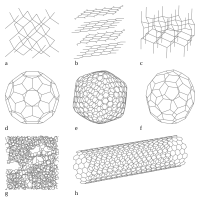
Photo from wikipedia
Polymeric reverse osmosis (RO) membranes are widely used worldwide for production of fresh water from various sources, primarily ocean desalination. However, with limited service life, exhausted RO membrane modules often… Click to show full abstract
Polymeric reverse osmosis (RO) membranes are widely used worldwide for production of fresh water from various sources, primarily ocean desalination. However, with limited service life, exhausted RO membrane modules often end up as plastic wastes disposed of predominantly by landfilling. It is imperative to find a feasible way to upcycle end-of-life RO membrane modules into valuable products. In this paper, the feasibility of RO membrane recycling via pyrolysis and subsequent conversion of resulting char into carbon dots (CDs) through H2O2-assisted hydrothermal method was investigated. RO membrane module pyrolysis at 600 °C produced oil (28 wt%), non-condensable gas (17 wt%), and char (22 wt%). While oil and gas can serve as fuel and chemical feedstock due to rich hydrocarbon content, char was found a suitable precursor for the synthesis of functional CDs. The resulting CDs doped with N (4.8%) and S (1.8%) exhibited excellent water dispersibility, narrow size distribution of 1.3-6.8 nm, high stability, and strong blue fluorescence with a quantum yield of 6.24%. CDs demonstrated high selectivity and sensitivity towards Fe3+ in the range of 0-100 μM with the limit of detection of 2.97 μM and were capable of determining Fe3+ in real water samples (tap water and pond water).
Journal Title: Journal of hazardous materials
Year Published: 2021
Link to full text (if available)
Share on Social Media: Sign Up to like & get
recommendations!